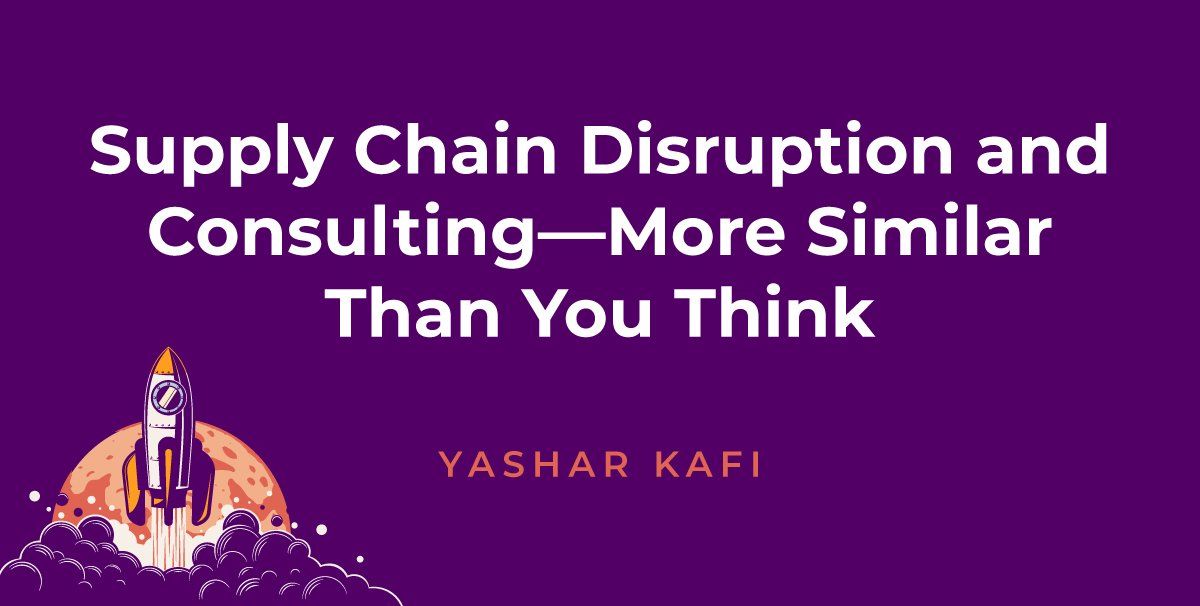Supply Chain Disruption and Consulting—More Similar Than You Think
Let’s talk about supply chain disruption. If there’s anything COVID, the Suez Canal blockage, war, or terrorism has shown us, it’s the delicate balance some household goods face getting to our shelves during times of disruption. Remember the rush there was to panic buy toilet paper at the beginning of the pandemic? That was a minor concern compared to the millions of others across the globe who were faced with shortages of far more vital goods, such as Neodymium, food supply, medical supplies (PPE, anyone?), and even oxygen.
Philosopher George Santayana hits the nail on the head with his following quote, and while he was not addressing procurement specifically in his thoughts, they still apply. Santayana warned, “Those who do not learn history are doomed to repeat it.”
What do I take from this quote, and how does it relate to procurement? Michael Cadieux, procurement guru leader of the Procurement Foundry, offered his unique spin about how it pertains to the industry. Cadieux claimed that he prefers to think of the quote in slightly different terms: “Those who do not ‘own’ the past are forced to ‘react’ to future events.” Cadieux explains how this calls for a new proactive approach to procurement and even offers an example. “While we cannot plan for every contingency, we can still take measures to lay the foundation for a proactive response in the face of unforeseen events. For example, no one could have predicted that the current coronavirus outbreak would spread faster and perhaps have a greater impact than the SARS outbreak in 2003. And yet, we might still have learned from SARS in ways that would have prepared procurement to deal with the present day situation and its related challenges.”
So, you may be wondering, how could procurement be better prepared? What does proactive ownership of this situation mean, exactly? Cadieux shares how business agility (having the capability to respond to both expected and unexpected events with speed and accuracy) and proactive planning are key: “We are not suggesting that procurement somehow missed an opportunity to prevent the supply chain interruptions we now read about on a daily basis. However, proactive planning is all about getting ahead of crises, both seen and unseen, and taking ownership of risk is the first step.”
What to Do Now?
I believe that we should take hold of the reigns by treating the supply chain like we treat consulting in an organization, implementing multiple solutions, and embracing technology. What I mean by this is that we don’t just provide one fixed solution. Instead, we provide multiple solutions for one fix.
The challenge is that many clients only want that one problem fixed and are not necessarily looking ahead proactively to fix a problem they don’t know they have. Put simply: businesses aren’t looking at things holistically as to what all the different factors are that are causing the shortage/disruption.
Diversify
One huge step you can take to prepare yourself for whatever may come is by diversifying your supply chains to ensure you aren’t left in the lurch if things go haywire with what would have been a sole supplier. This means you can’t keep relying on the old traditional models. Instead, you have to find alternatives, where you have what I would call a “bare bones supply chain” in a different country that’s closer to where your products are being sold. You can flip a switch, and that production can ramp up very quickly to supplement the loss of any production where you are or where you originate your production from.
The 80/20 Rule
Regarding how to choose the technology that will help you most in this process, I like to use what I refer to as the 80/20 rule. No technology is going to meet 100% of your needs. However, if it meets 80% of your needs and the remaining 20% is a light lift, or someone can do it without it being a manual or a full-time job, that will meet your needs.
Again, the problem is that everybody is trying to find the perfect solution. But there is no perfect solution unless you build it, and by the time you build it, technology’s evolved seven times. Hence, the 80/20 rule applies to figure out what works for the bulk of your requirements; then, you’re able to manually accomplish the remaining 20%.
As Chinese general and military strategist, Sun Tzu said so perfectly, “The line between disorder and order lies in logistics,” so get planning.
We’re here to help you on your way; contact us today.




